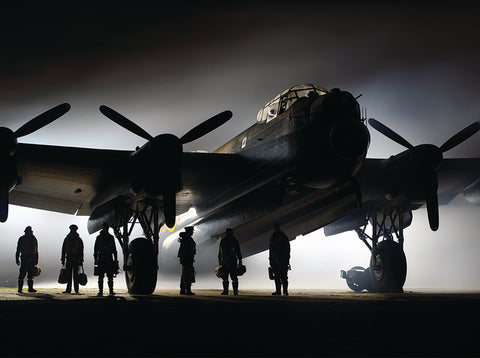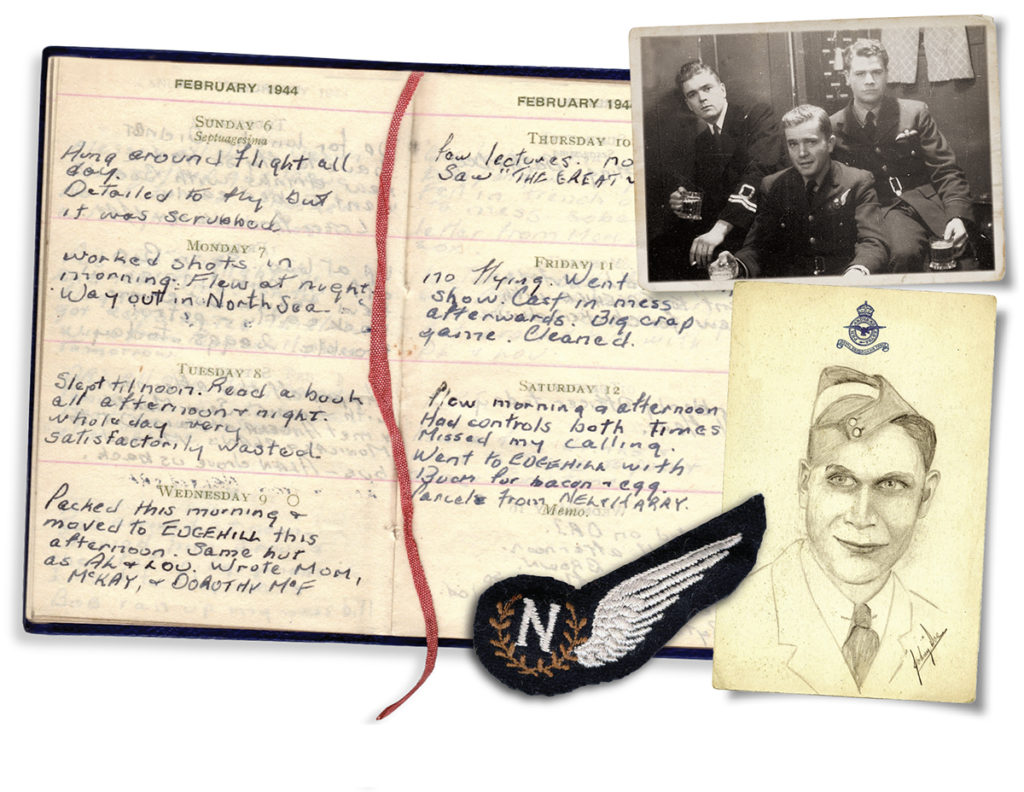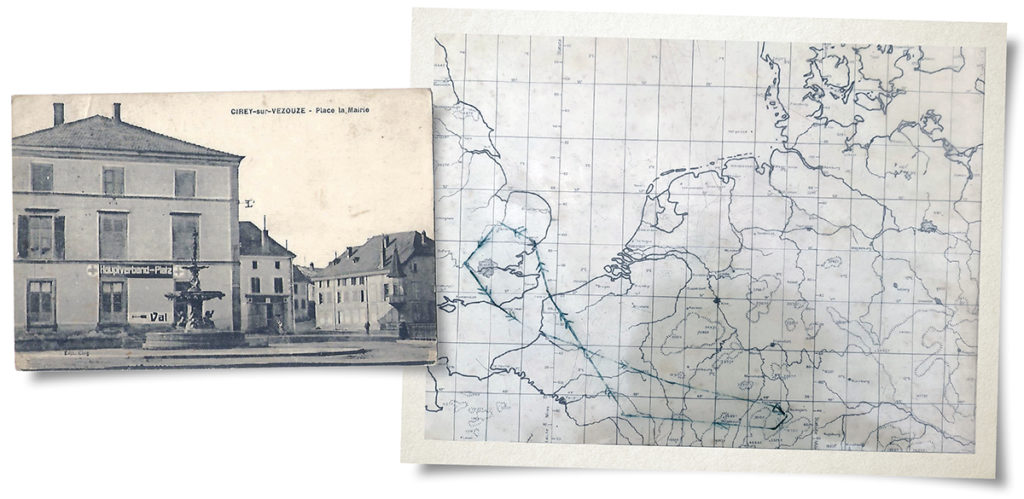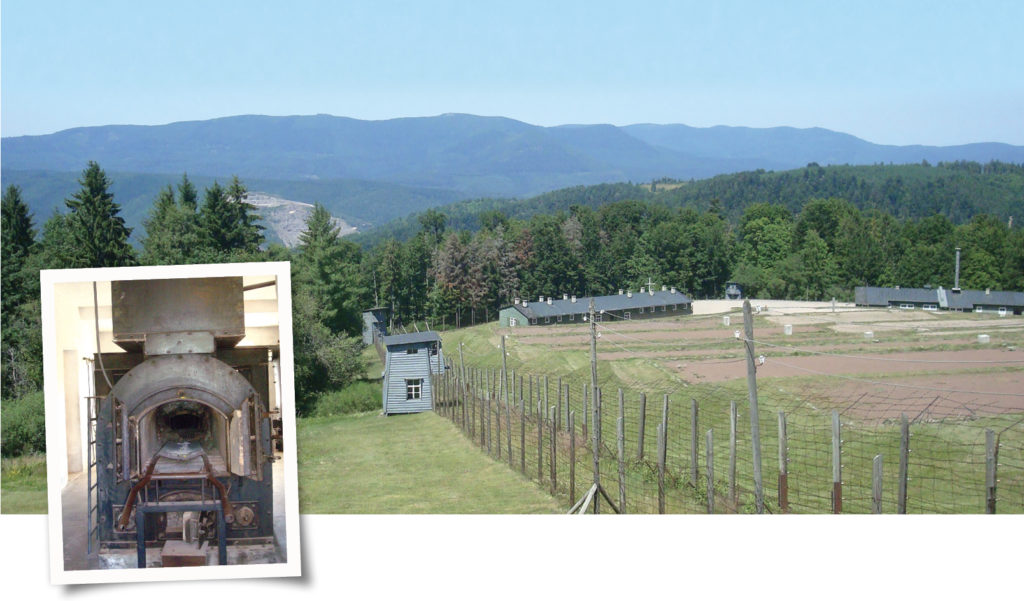
What Happened to the Two Canadian Aviators of Lancaster L7576?
Harry Doe started keeping a diary in January 1944. It was going to be a monumental year and the 21-year-old Canadian wanted a record for posterity.
Harry’s elder brother, Robert, had enlisted in the navy, but there was only one branch of service for Harry—the Royal Canadian Air Force. His father had been a pilot in the First World War, and Doe had grown up obsessed with aircraft. As an adolescent, he had been a talented model-maker and won several competitions with his creations. He joined the air force in 1941 at the age of 18 as a mechanic and the following year he was sent to Edmonton, Alberta, for aircrew training. After completing the technical training school, Doe started air observer’s school and in August 1943 he was commissioned as pilot observer and awarded his navigation wings.
Left to right: Lew Fiddick, Harry
Doe and Harold S. “Al” Peabody relax between missions at No.622 Squadron’s
base, RAF Mildenhall, in June 1944. Doe and Peabody had about a month left to
live. Fiddick would find himself behind enemy lines in occupied France,
spending weeks with French guerrillas and with British Special Air Services
(SAS) soldiers. (Courtesy the Doe Family)
Soon afterward, Doe shipped out to Britain for first posting to the Advanced Flying Unit, Royal Air Force Wigtown, in the southwest of Scotland. He arrived at the start of 1944. It was cold and wet, but Doe didn’t care. He was leading the life he had dreamed about for years. At the front of his diary Doe penned a brief poem:
If I should die
and you bury me
And send my things
across the sea,
One favor, ere
you let me be
Please burn this
ruddy diary.
 Clockwise from left: Harry Doe started keeping a diary in January 1944, but he
wanted it destroyed if he died during the war; (left to right) Bob Doe,
brother Harry Doe and Al Peabody enjoy time off in London in July 1944; Harry
sketched this portrait of an unknown fellow serviceman; as a RAF navigator,
Harry would have worn wings like these. (Courtesy the Doe family; wings from
HistoryNet Archives)
Clockwise from left: Harry Doe started keeping a diary in January 1944, but he
wanted it destroyed if he died during the war; (left to right) Bob Doe,
brother Harry Doe and Al Peabody enjoy time off in London in July 1944; Harry
sketched this portrait of an unknown fellow serviceman; as a RAF navigator,
Harry would have worn wings like these. (Courtesy the Doe family; wings from
HistoryNet Archives)
Doe spent the first fortnight of 1944 flying, sleeping and drinking. It was a good life, but one that didn’t leave much time to commit his innermost thoughts to his diary. Rather than record his emotions, Doe simply noted his activities. On January 10 he took the train south to his new station, RAF Chipping Warden, which was in Oxfordshire, 75 miles northwest of London. Shortly afterward, at a mess dinner, Doe hit it off with a fellow Canadian named Harold Sherman Peabody, or Al, as he preferred.
In fact, Peabody, whom Doe described in his diary as a “good type,” had been born in 1920 not in Canada but in Cambridge, Massachusetts, where his father worked for the Canada Life insurance company. He was a baby when the family relocated to Quebec. At Bishop’s University in Quebec, the handsome Peabody had been a star athlete on the golf and hockey teams before he quit his studies to enroll in the Commonwealth’s flight-training program in Windsor Mills, Quebec. Sport helped Peabody bond with Doe as the two young men drank their beer in the mess. Doe had been a talented footballer and boxer at high school, where he had won the lightweight title in the Greater Victoria Schoolboy Boxing Competition.
It ended up being a raucous night. By the end, the officers were climbing the rafters, yelling and hollering in drunken ecstasy. “Very stiff,” Doe noted in his diary the next day.
Doe and his crewmembers flew aboard
a Lancaster bomber like this one of No. 619 Squadron, RAF. (IWM CH12352)
The following weeks were mundane. Most of the time was spent in the classroom, but gradually a crew began to form. “Got a gunner—Buckley,” wrote Doe in his diary on January 20. Sergeant Percy Buckley was a streetwise 18-year-old from London, a likeable fellow whom Doe and Peabody invited to be their rear gunner.
By the beginning of February they had a bomb-aimer, Flying Officer Lew Fiddick. Born in British Columbia, Fiddick was an outdoorsman who had been working as a logger in Nanaimo, Vancouver Island, when war was declared. Fiddick was 27 and had a quiet maturity that impressed Peabody. Not an educated man in the academic sense, he nonetheless was sharp and intelligent, the sort of man on whom one could rely. Fiddick, Peabody and Doe shared a hut when they moved into their new base at RAF Edgehill in mid-February.
A Messerschmitt Me-110G-4 of Nachtjagd-
geschwader 6 is similar to that piloted by Leutnant Walter Swoboda on the
night of July 28-29, 1944, when he scored his first and only aerial victory.
Pilots called the night fighter’s radar antennas “deer antlers.”
(Bundesarchiv Bild 101I-659-6436-12)
They were flying regularly by this point and Doe was mastering the skills particular to his job as navigator. He attended lectures about astronavigation, practiced on dead-reckoning instruments and, most difficult of all, became familiar with Gee, a radio navigation system developed in the late 1930s that triangulated position based on the time delay between two separate transmitters.
Fortunately for Doe there was plenty of light relief to be had at RAF Edgehill. “Went to Policemen’s Dance in Banbury with Al and Lew,” he wrote in his diary on February 23. “Quite drunk.” The next day he flew despite having a “splitting headache.”
When his training period at RAF Edgehill ended on March 25, Doe spent an extended leave in London, taking in shows and taking out girls. His leave ended the second week of April but it wasn’t until the end of May that he was posted to the Lancaster Finishing School at RAF Feltwell in Norfolk in the east of England. This was the last step before he became operational. That day arrived on an auspicious date: June 6. “INVASION,” wrote Doe in capital letters in his diary, adding: “Posted to 622 SQN. Bit of a piss-up.”
Manning the upper machine guns on
Lancaster L7576 that night was 21-year-old Richard Proulx. (Courtesy the Doe
Family)
No. 622 Squadron had been formed the previous year and was based at RAF Mildenhall, also on the eastern side of England. It had first flown Stirling Mk III bombers but since December the crews had been re-equipped with Lancaster Mk IIIs and operated as part of No. 3 Group in RAF Bomber Command’s main force.
Doe flew his first combat missions on June 23, a daylight attack on a V-2 rocket site near St.-Omer in northern France. His third mission took place on June 30 when the RAF launched a daylight raid on German positions in Villers- Bocage in Normandy. The town, 20 miles inland from the invasion beaches, had been the scene of fierce fighting since the British launched Operation Epsom on June 26 to continue the offensive into France. Doe’s Lancaster was one of nearly 250 RAF bombers that flattened Villers-Bocage; it didn’t lead to a decisive British victory but it helped inflict damage on the Germans from which they never recovered.
The relief for Doe on returning safely to base after that mission was particularly acute because the next morning, July 1, he embarked on an extended leave, the first five days of which dovetailed with his brother’s furlough from the navy. The two Doe brothers spent the time in London in the company of some delightful Red Cross girls.

Cirey-sur-Vezouze was the French village where Lew Fiddick found assistance
after being shot down. Right: This map shows the route taken by L7576 on its
97th mission, a few days before its final flight. The target both times was
Stuttgart, so this is the same course the Lancaster would have followed on its
99th and last assignment. (left: HistoryNet Archives; right: courtesy the Doe
family)
Doe’s leave ended on July 10 and for the next week he was on standby. On July 17 he was recalled from a daylight raid shortly before take-off for a reason that Doe didn’t explain in his diary. The next day the squadron bombed Caen in a daylight raid. On July 20 the target was the town of Homberg, the first time Doe had flown a mission over Germany. On July 23 he flew a night raid on Kiel and the following evening the target was Stuttgart in southwest Germany.
The mission for July 27 was scrubbed, so Doe and the rest of the crew went to a show instead. By now they were connected by a strong bond. Doe, Peabody and Fiddick had become friends as well as comrades, and Percy Buckley was also a valued member of the crew. Another Briton in the crew, 29-year-old Arthur Payton, was a competent wireless operator and the only married man among them. He had wed in the summer of 1939, shortly before he resigned from his job as a steelworker to volunteer for the RAF. The upper gunner was 21-year-old Richard Proulx from Ontario. Like Payton, he had flown several missions with Peabody. The flight engineer was Sergeant David Cosgrove.
On July 28, Cosgrove was sick, so Lieutenant George Wishart took his place for a mission to Stuttgart that night. He was an experienced man to have as a late substitute. Born in London to Scottish parents, Wishart had joined the RAF at the age of 21 in 1935 and had been commissioned in May 1943.
Like the rest of the crew, Wishart was unfamiliar with the aircraft they would fly that night. The crews were not assigned to specific aircraft; instead, they flew the airplanes that were available at the time. None of them had flown in Lancaster L7576 before, but it had a legendary status within the squadron. Having survived 98 missions, it was considered a lucky “crate.” At 10:00 on the evening of July 28 Lancaster L7576 lifted off with payload of five 1,000-pound bombs and two 500-pounders, all of which were to be dropped over Stuttgart’s railway yards.
There are approximately 500 miles between RAF Mildenhall and Stuttgart, a route that took the 500 RAF aircraft south over eastern France. Sixty-two of the aircraft failed to return. Lancaster L7576 was one of them.
At approximately 1:25 on the morning of July 29, Walter Swoboda picked up his prey on the radar of his Messerschmitt 110G-4, the latest model of the twin-engine fighter-bomber. The Messerschmitt was a feared night fighter, equipped with Lichtenstein radar that enabled it to latch onto enemy aircraft in the darkness. But the 22-year- old Swoboda was a relatively inexperienced pilot with no victories. The first burst of cannon fire he shot at his target went wide of its mark. Surprise was no longer on the German’s side. The Canadian pilot put his aircraft into a “corkscrew,” flipping the bomber onto its side and diving for a few hundred feet before ascending. Swoboda had been taught about this defensive maneuver and pumped fire into the Lancaster as it came slowly out of its dive. “Almost immediately as we levelled off we were hit,” said Lew Fiddick. “I still remember the bullets hitting the aeroplane—just a steady stream.”
The fire from the Me-110 ripped through the Lancaster, killing Percy Buckley in the rear turret, Richard Proulx in the upper turret and wireless operator Arthur Payton. Bullets also shot away the tail control, crippling the aircraft. Fiddick squeezed out of the forward turret and met engineer George Wishart, who had come down from above, in the nose section. Both knew the aircraft was doomed. Wishart yanked the release handle of the escape hatch and plunged through the hole into the darkness. Fiddick was about to follow when he thought of Peabody and Doe in the cockpit. They were his buddies. He had to see if he could help. He crawled toward the cockpit, but the Lancaster was in its death throes. He felt a series of violent shudders and then a massive jolt hurled Fiddick backwards and through the escape hatch. “The next thing I knew I was falling through the air,” he remembered.

Natzweiler-Struthof, the only Nazi concentration camp built on French soil,
probably figured in the deaths of Harry Doe and Al Peabody. The grounds may
appear bucolic today, but the crematorium hints at the horrors that took place
here during the war. (Gavin Mortimer)
Fiddick crashed through saplings as he fell to earth beneath his parachute. His leg hurt and his senses were still scrambled but he had the wherewithal to bury his parachute and Mae West. He suspected he had come down in northeastern France but did not know where. He decided to limp south. Not long after daylight on July 29 he spotted the village of Cirey-sur-Vezouze. For two days he hid in the undergrowth, observing the villagers and wondering whether it would be safe to approach them. Like all aircrews, he had been briefed that this rugged and thickly forested region had a particular history. Germany and France had fought over it for 75 years and it had changed hands on several occasions; as a result a minority of inhabitants had German ties and was loyal to the Fatherland.
Ultimately, hunger got the better of Fiddick and he hobbled into Cirey-sur- Vezouze. “I finally knocked at a house and the people took me in and fed me,” he said.
The villagers were aware that an aircraft had come down. One, 17-year-old Pierre Vinot, the son of a forest ranger, had arrived at the crash site on the morning of July 29. The Germans had beaten him to it, however, and were sifting through the wreckage. “I saw two dead—they were all in one piece—and another one who was dismembered,” Vinot remembered. “Dogs were eating this third man.” The Germans allowed the locals to remove the dead and bury them in the churchyard of Petitmont. The Germans then began scouring the countryside for the remaining crew members.
Fiddick was passed into the care of Leonard Barassi, a 44-year-old Italian who had lived in the region for years and was loosely involved with the resistance effort. He sheltered the Canadian for a few days until “on the afternoon of August 4 a member of the Maquis came and took me to the Maquis camp.”
The Maquis were the guerrillas of the French Resistance and Fiddick remained with them in their forest hideout for nearly two weeks. Then, on August 15, the Maquis handed him over to Captain Henry Druce, the officer in charge of 13 British Special Air Service (SAS) soldiers, an elite regiment that had been waging a guerrilla campaign against the Germans in Occupied France since early June. Druce’s section was the advance party for a larger operation codenamed Loyton, with the mission of harrying the Nazis in conjunction with the local Maquis as the Germans withdrew east ahead of the advancing U.S. Third Army. “A Canadian pilot called Fiddick joined us,” Druce wrote in his operational log. “He had been shot down and had injured his leg, which made walking difficult.” For his part, Fiddick was relieved to be “finally among people I could understand!”
this article first appeared in AVIATION HISTORY magazine
In December 2003 I traveled to Vancouver Island to meet Lew Fiddick and Henry Druce for a book I was writing about the SAS. Fiddick had been made an honorary member of Druce’s regiment for his exploits during Operation Loyton. He had proven to be a born guerrilla fighter, one of Druce’s most reliable men during the weeks behind enemy lines. “Having grown up on Vancouver Island, the forest was an environment in which I felt comfortable,” he told me. “I took to the SAS type of warfare quite quickly and it was interesting work.”
Fiddick provided the SAS with crucial skills they didn’t possess. During one of their frequent nighttime resupplies by the RAF, the SAS took Fiddick to the selected drop zone. “He was able to tell from the sound of the engine whether an aircraft belonged to the enemy or the Allies,” remembered SAS Captain John Hislop. “This was a help, as several of the planes to pass over the D.Z. had been German ones. He identified this one as British, and when it was directly overhead we gave the signal. It was answered correctly from the plane, which then wheeled round for the run-in.”
When Fiddick returned to England in October 1944 he told the RAF that, as far as he was aware, only he and Wishart had bailed out of the Lancaster. (Wishart had been badly injured on landing and was found by the Germans. He spent the rest of the war as a POW and remained in the RAF post-war.) However, Fiddick did relay to the RAF’s Missing Research and Enquiry Service (MRES) what he had been told by the Maquis—that two airmen had been spotted close to where the Lancaster came down. But that was where the trail of Doe and Peabody went cold.
An MRES team visited the crash site in 1947 but could not determine what had happened to the two missing airmen. They wrote in their report that Doe and Peabody “either drifted over the then German border during their parachute descent and were apprehended there, or were still in the aircraft when it exploded and were blown to pieces.”
But if the two men had been apprehended by the Germans, why had they disappeared off the face of the earth? The mystery remained unsolved when Fiddick died in 2016 in his 100th year; but the puzzle was already in the process of being pieced together.
Canadian brothers Jon and Robert Peck provided the impetus for the investigation of Lancaster L7576. Their late mother had been Al Peabody’s second cousin and in 2016 they launched the Peabody Project to try and discover what happened to Al and his buddy Harry Doe. They enlisted the help of Bishop’s University, where Al Peabody had made such an impression 75 years earlier. Three undergrad students there threw themselves into the search for answers. Rick Doe, Harry’s nephew, passed over to the students what he had in his possession, including Harry’s diary from 1944 and his flight log.
The students’ diligence paid off. Among the piles of documents they sifted through were files from the British army’s War Crime Investigations Team. The team had been particularly active in northeastern France because 29 SAS soldiers of Operation Loyton had, like Doe and Peabody, vanished there during the war. Major Eric Barkworth, a tenacious and astute detective who had tracked down dozens of Nazis in the months after the war, had led the SAS investigation. He determined that the captured SAS soldiers had all been executed over the course of several weeks, some individually but most often in small groups. At some point before being murdered, most of the SAS prisoners had passed through a prisoner transit camp called Schirmeck, three miles from Natzweiler-Struthof, the only Nazi death camp in France.
A memorial to the crew of Lancaster L7576 was
dedicated in France in 2019. (Courtesy the Doe Family)
Barkworth also ascertained that three airmen had been executed at Natzweiler, one of whom was Sergeant Fredric Habgood, a British member of a Lancaster that had been shot down on the same night as L7576. Habgood was hanged on July 31 and his corpse incinerated in the camp’s oven. It had not been possible to identity the other two airmen who had been killed at Natzweiler but a Nazi guard identified Peabody as one from a photograph. In his report on the deaths of the two airmen, who were “wearing combination overalls of a lighter shade than battledress khaki, fitted with zip fasteners on front,” Barkworth said it was “possible” they were from L7576. It is now almost certain that Peabody and Doe were indeed the mystery airmen, since there were no other unaccounted Allied aircrew who had bailed out at that time in the region.
(Standing left to right) Robert Peck, Jon Peck, Rick Doe and Jon Peck Jr.
Richard Coplen sits in front. His great-uncle was Percy Buckley, the tail
gunner. The Pecks launched the Peabody Project in 2016 to get to the bottom of
what happened to Al Peabody, their mother’s second cousin. Rick Doe is Harry
Doe’s nephew. (Anne Ackermann)
Seventy-five years later a memorial was unveiled near the site of the Lancaster’s crash. Military and diplomatic dignitaries from France and Great Britain attended, as did relatives of the crew who traveled from their homes in Ireland, California, Quebec and British Columbia. Among them was Rick Doe, there to remember his uncle Harry, who in jest had written three quarters of a century earlier that in the event of his death his “ruddy diary” should be burned. Thankfully it wasn’t, and today it stands as a testament to a brave young man whose luck ran out on the 99th flight of Lancaster 7576. _ _
Gavin Mortimer is a British historian who has written extensively about World War II special forces. His latest book is David Stirling: the Phoney Major , which was published in the U.S. in August 2022.
What Happened to Walter Swoboda?
The shootdown of Lancaster L7576 was Leutnant Walter Swoboda’s first victory. It was also his last. Sometime in July 1944 Swoboda, an Austrian, transferred from the 2nd to the 6th Staffel of Nachtjagdgeschwader 6. On the night December 17-18, 1944, his Me-110G-4 went missing, apparently after being hit by anti-aircraft fire from the U.S. Army 204th Field Artillery near Felsberg. The remains of Swoboda and his crewmen, Unteroffiziere Ernst Meier and Franz Dinger, were never found. —Jon Guttman
